

DECEMBER • VOL. 12 • SERIES OF 2024
INSIGHTS is a monthly publication of BDB LAW to inform, update and provide perspectives to our clients and readers on significant tax-related court decisions and regulatory issuances (includes BIR, SEC, BSP, and various government agencies).
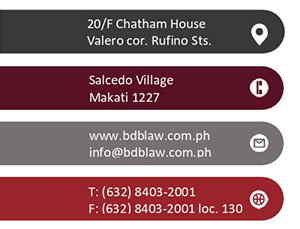
DISCLAIMER: The contents of this Insights are summaries of selected issuances from various government agencies, Court decisions, and articles written by our experts. They are intended for guidance only and as such should not be regarded as a substitute for professional advice.
Copyright © 2024 by Du-Baladad and Associates (BDB Law). All rights reserved. No part of this issue covered by this copyright may be produced and/or used in any form or by any means – graphic, electronic, and mechanical without the written permission of the publisher.
What's Inside ...
- HIGHLIGHTS FOR NOVEMBER 2024
- SIGNIFICANT COURT DECISIONS
- Court of Tax Appeals
- SIGNIFICANT REGULATORY ISSUANCES
- Bureau of Internal Revenue
- PUBLISHED ARTICLE
- Reformed Tax Incentives under CREATE MORE
- OUR EXPERTS
- GLOSSARY


HIGHLIGHTS for NOVEMBER 2024
COURT OF TAX APPEALS DECISIONS
- The BIR, like any other police or law enforcement agency, is not exempt from the fundamental requirement of obtaining a search warrant from the court before making searches and seizures. (People v. GB BEM Cigarette Co., Inc., CTA Crim. Case No. O-935, November 20, 2024)
-
The mere identity of the basic VAT amounts in the PAN and FAN cannot be construed as a deprivation of property without due process of the law. (GComm Business Supplies Corporation. v. Commissioner of Internal Revenue, CTA Case No. 10696, November 19, 2024)
-
If the applicant is a direct exporter, the administrative claim for VAT refund "shall be exclusively filed" with the VAT Credit Audit Division. (BW Shipping Philippines, Inc. v. Commissioner of Internal Revenue, CTA Case No. 10317, November 19, 2024)
- The Philippines-Thailand Tax Treaty provides that the Philippine government may rightfully tax the gains that a Thailand resident derives from the alienation of shares of a domestic company only when there is a showing that the property of the said company consists principally of immovable properties situated in the Philippines. (Cal-Comp Precision (Thailand) Limited v. Commissioner of Internal Revenue, CTA Case No. 10899, November 19, 2024)
- Neither R.A. No. 10378 nor RR No. 15-2013 mandates the international carrier invoking a preferential income tax rate based on an applicable tax treaty to also prove reciprocity in order to be entitled to such preferential income tax rate. (Commissioner of Internal Revenue v. Kuwait Airways Corporation, CTA EB No. 2798, November 4, 2024)
- In order to be considered a branch, sales office or warehouse for LBT purposes, it must be shown that, for the subject period, the taxpayer conducted business therein, or that in such fixed place or location, there was trade or commercial activity regularly engaged in by the taxpayer, as a means of livelihood or with a view to profit. (NLEX Corporation (Formerly Manila North Tollways Corporation vs. The City of Valenzuela, CTA AC No. 297, November 18, 2024)
- Fraud is not presumed, as it must be proven by clear and convincing evidence. (The City Government of of Valenzuela vs. NLEX Corporation, CTA AC No. 296, November 15, 2024)
- The increased excise tax rate per liter on beer products may only be imposed beginning February 10, 2020. (San Miguel Brewery, Inc. vs. Commissioner of Internal Revenue, CTA Case No. 10745, November 18, 2024).
- Using phrases such as “requested to pay” or “requested to settle” does not negate an unequivocal demand for payment of deficiency taxes. (Hawaiian-Philippine Company vs. Commissioner of Internal Revenue, CTA EB No. 10726, November 13, 2024)
- A LOA is valid even if it covers more than one taxable year, provided that the other periods or years shall be specifically indicated in the LOA. (Commission on Elections vs. Commissioner of Internal Revenue, C.T.A. Case No. 10588, November 13, 2024)
- The five (5)-day reglementary period under the Revised Guidelines applies solely to filing an MR on the specific meritorious motions expressly listed therein. (People of the Philippines vs. Logistics.Com Corporation, C.T.A. EB Crim No. 114 (CTA Crim Case No. O-973, November 8, 2024)
- RMC No. 039-13 provides that a taxpayer may validly file a protest to the following: the concerned Regional Director (RD), (2) ACIR-LTS, and (3) ACIR-ES. (Alphaland Balesin Resort Corporation v. Commissioner of Internal Revenue, C.T.A. Case No. 10485, November 5, 2024)
- In order to justify the seizure of respondent's subject shipment, petitioner must show actual and intentional fraud. (Commissioner of Internal Revenue v. Globe Telecom, Inc., C.T.A. EB Case No. 2782 (C.T.A. Case No. 9883), November 14, 2024)
- If the protest is wholly or partially denied by the CIR or his authorized representative, then the taxpayer may appeal to the CTA within 30 days from receipt of the whole or partial denial of the protest. (Elta Industries, Inc. vs. Commissioner of Internal Revenue, CTA EB No. 2770, November 28, 2024)
- The taxpayer must be exclusively engaged in the sale and/or manufacture of essential commodities to be entitled to the preferential rate under Section 143 (c) (8) of the LGC of 1991. (Holcim Philippines, Inc. vs. The City of Manila and Josephine D. Daza, in her capacity as the City Treasurer of the City of Manila, CTA EB No. 2758, November 26, 2024)
- Without the date of receipt stamped on the face of the FDDA, the Court treats the date of the FDDA as the reckoning point of the 30-day period to file the Petition for Review with the CTA. (Goodyear Steel Pipe Corporation vs. Commissioner of Internal Revenue, CTA Case No.10541, November 25, 2024)
- In case of fraud or intent to evade the payment of taxes, fees, or charges, the same may be assessed within ten (10) years from discovery of the fraud or intent to evade payment. (The City of Valenzuela and Hon. Adelia Soriano in their capacity as City Treasurer vs. NLEX Corporation, CTA Case No. 290, November 25, 2024.)
-
Only decisions or rulings issued by the Commissioner of Customs are subject to appeal before the CTA. Inaction by the COC on matters involving customs duties, fees, or other monetary charges does not fall within the jurisdiction of the CTA. (L.T.J.S. STORE, represented by its Owner/Proprietor, MR. ANTONIO DE JESUS SILVA vs. Hon. Collector of Customs, et. al, CTA Case No. 10581, November 13, 2024)
BIR ISSUANCES
-
RMO No. 48-2024, November 15, 2024 – This order implements the new DX Roadmap for CY 2025-2028, ordering that programs and activities to be undertaken must be aligned with the new roadmap.
-
RMO No. 047-2024, November 12, 2024 - This order prescribes the use of revised BIR Form No. 1770 as a monitoring tool to more effectively profile taxpayers.
-
RMC No. 123-2024, November 15, 2024 - The 3-year validity period of the Certificate of Tax Exemption shall not apply to non-stock and non-profit educational institutions, Homeowners’ Associations, Non-stock savings and loan associations, and Employees’ retirement benefit plans.
-
RMC No. 124-2024, November 15, 2024 – This provides for the circularization of ERC Resolution No. 10, Series of 2023, entitled “A Resolution Suspending the Inclusion of the National Franchise Tax of the National Grid Corporation of the Philippines (NGCP) in the Total Monthly Transmission Cost Billing of Distribution Utilities.”
-
RMC No. 125-2024, November 15, 2024 – This provides for the amendment of certain provisions of RMC No. 095-2017, Providing Guidelines on the Tax Treatment of the Government Securities Repurchase Transactions Governed by the Global Master Repurchase Agreement.
-
RMC No. 127-2024, November 18, 2024 – This provides for the waiver/removal of the certification fee in the processing of application for certificate of exemption for scholarship and job/livelihood programs.

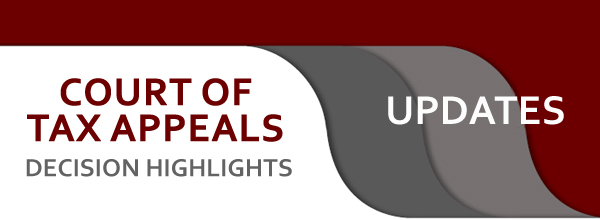
The BIR, like any other police or law enforcement agency, is not exempt from the fundamental requirement of obtaining a search warrant from the court before making searches and seizures.
The accused were charged with violating Section 263 of the NIRC for being in possession of locally manufactured cigarettes or tobacco products subject to excise tax, where the tax has not been paid in accordance with law.
The prosecution argued that the search and seizure of the BIR Strike Team was legal as the BIR is an agency tasked to give effect to the supervisory and police powers conferred to it by the NIRC. Meanwhile, the accused maintained that the cigarettes were illegally confiscated without warrant.
The Court ruled that Section 6 of the NIRC and Section 11 of RR No. 7-2014 do not provide for the seizure of cigarette products and closure of business as an appropriate penalty during the conduct of surveillance.
The Court reminded that while the BIR may possess the supervisory and police powers conferred to it by law and the investigative power to enter any house, building, or place to search for taxable articles, the authority of the BIR to make arrests and seizures is not unbridled. The same remains subservient to the people’s right against unreasonable searches and seizures as enshrined in the Constitution. The BIR, like any other police or law enforcement agency, is not exempt from the fundamental requirement of obtaining a search warrant from the court before making searches and seizures.
With the inadmissibility of the cigarette products, the conviction cannot be sustained. (People v. GB BEM Cigarette Co., Inc., CTA Crim. Case No. O-935, November 20, 2024)
The mere identity of the basic VAT amounts in the PAN and FAN cannot be construed as a deprivation of property without due process of law.
The taxpayer prayed for the Court to the BIR’s assessment against the taxpayer for deficiency VAT.
The taxpayer argued that the FAN, Assessment Notice, FDDA, and Amended Assessment Notice are all void due to the BIR's failure to consider the merits of the explanations in and documentary evidence submitted relative to its Reply to PAN. On the other hand, the BIR countered that the taxpayer was afforded due process in the assessment of its deficiency taxes.
The Court upheld the validity of the subject assessment, noting that while the FAN contained the same basic VAT amount as indicated previously in the PAN, it cannot be said that the taxpayer’s Reply to the PAN was totally disregarded. To the contrary, it was acknowledged in the FAN and made part of the BIR Records. Accordingly, when the arguments in and documents supporting the Reply were re-pleaded and re-submitted relative to its administrative protest to the FAN, these were duly accepted by the BIR and appreciated in favor of the reduction of the taxpayer’s deficiency VAT liability.
Hence, the mere identity of the basic VAT amounts in the PAN and FAN cannot be construed as a deprivation of property without due process of the law. (GComm Business Supplies Corporation. v. Commissioner of Internal Revenue, CTA Case No. 10696, November 19, 2024)
If the applicant is a direct exporter, the administrative claim for VAT refund "shall be exclusively filed" with the VAT Credit Audit Division (VCAD).
The taxpayer prayed for the refund of its unutilized input VAT. However, the BIR argued that the taxpayer wrongly filed its administrative claim with the RDO, instead of with the
The Court agreed with the BIR and ruled that the taxpayer failed to file its application for VAT refund with the correct office of the BIR and, thereby, failed to timely file its administrative claim for refund.
As a general rule, applicants for VAT refund or credit shall file their administrative claim with the Large Taxpayers Service or the RDO that has jurisdiction over the principal place of business of the taxpayer. If the applicant is a direct exporter, the administrative claim "shall be exclusively filed" with the VCAD.
Here, as a manning agency that supplies Filipino seafarers to foreign shipping companies, the taxpayer is a direct exporter of services. Hence, the taxpayer should have filed its claim for input tax refund with the VCAD, the office which has jurisdiction over its claim. It, however, erroneously filed its application for VAT refund before RDO No. 49-North Makati. (BW Shipping Philippines, Inc. v. Commissioner of Internal Revenue, CTA Case No. 10317, November 19, 2024)
Under the Philippines-Thailand Tax Treaty, the BIR may rightfully tax the gains that a Thailand resident derives from the alienation of shares of a domestic company only when there is a showing that the property of the said company consists principally of immovable properties situated in the Philippines.
The taxpayer sought the refund of the allegedly erroneously paid , arising from the sale of its shares of stock in its domestic corporation. The taxpayer anchored its refund claim on its alleged tax exemption pursuant to the Philippines-Thailand Tax Treaty, which provides that the Philippines may tax any gain from the disposition of an interest in a corporation if its assets consist principally of real property interest located in the Philippines.
The taxpayer contended that at the time of the Share Transfer Agreement’s execution, CPPH's real property interest in the Philippines did not exceed 50% of its total assets, hence, exempt from CGT.
The Court agreed with the taxpayer.
Under the NIRC, the capital gains realized during the taxable year from the sale or other disposition of shares of stock in a domestic corporation made outside the stock exchange and any gain derived from such dealings in property derived by a foreign corporation are subject to income tax. However, such gains are exempt or partially exempt to the extent required by any treaty obligation on
the Philippines, and one of the treaty obligations that binds the Philippine government is the Philippines-Thailand Tax Treaty.
Finding that taxpayer’s assets do not consist principally of immovable property, the net capital gain that the taxpayer derived from the sale of its common shares of stock of its domestic corporation is thus outside the taxing jurisdiction of the Philippines, pursuant to the Philippines-Thailand Tax Treaty. (Cal-Comp Precision (Thailand) Limited v. Commissioner of Internal Revenue, CTA Case No. 10899, November 19, 2024)
Neither R.A. No. 10378 nor RR No. 15-2013 mandates the international carrier invoking a preferential income tax rate based on an applicable tax treaty to also prove reciprocity in order to be entitled to such preferential income tax rate.
The BIR sought the reversal of the Court in Division’s decision and the denial of the taxpayer’s entire claim for refund of overpayment of income tax on its It argued that the taxpayer is not entitled to the relief sought, considering that it failed to establish that Philippine carriers are enjoying the same income tax exemption in Kuwait pursuant to provisions on reciprocity under RR No. 15-2013.
The Court En Banc held that a reading of RR No. 15-2013 shows that proof of reciprocity is required only if an international carrier invokes the same as basis for its GPB exemption. No law or BIR issuances mandate that an international carrier invoking a preferential income tax rate based on an applicable tax treaty to also prove reciprocity in order to be entitled to such preferential income tax rate.
Here, the taxpayer’s Application for Relief from Double Taxation on Shipping and Air Transport evidently shows that the same was for the availment of the preferential rate of 1 ½% on the basis of the Philippines-Kuwait Tax Treaty, not for exemption. Thus, there is no reason to deprive the taxpayer of its availment of the preferential tax rate of 1 ½% on its GPBs pursuant to the Philippines-Kuwait Tax Treaty, especially since the same had already been confirmed by no less than the Office of the CIR. (Commissioner of Internal Revenue v. Kuwait Airways Corporation, CTA EB No. 2798, November 4, 2024)
In order to be considered a branch, sales office, or warehouse for LBT purposes, it must be shown that, for the subject period, the taxpayer conducted business therein, or that in such fixed place or location, there was trade or commercial activity regularly engaged in by the taxpayer, as a means of livelihood or with a view to profit.
The LGU of the City of Valenzuela issued an Assessment against the taxpayer demanding it to pay and Other Charges in relation to its income earned from signages. This assessment stemmed from a letter requiring the taxpayer to secure sign permits for the signages it maintained along NLEX in Valenzuela City. Subsequently, the taxpayer paid under the protest the said assessment.
The taxpayer, in protesting the assessment, argued that it is not subject to the taxes imposed by the LGU. On the other hand, the latter argued that the taxpayer is entitled to pay the LBT, considering that it maintains signages in the city.
The Court in Division ruled that the Other Charges are mere regulatory fees and not taxes, hence, they are imposed in the exercise of its police power. On the other hand, the taxpayer is entitled to the refund of the LBT it erroneously paid.
In order to be considered a branch, sales office or warehouse for LBT purposes, it must be shown that, for the subject period, the taxpayer conducted business therein, or that in such fixed place or location, there was trade or commercial activity regularly engaged in by the taxpayer, as a means of livelihood or with a view to profit.
Since there is no showing that the signages or installations in Valenzuela City may be treated as any of these, there is no valid levy or collection of LBT, including the surcharge and interest incidental thereto, on the said signages or installations may be made by the LGU against the taxpayer. (NLEX Corporation (Formerly Manila North Tollways Corporation vs. The City of Valenzuela, CTA AC No. 297, November 18, 2024).
Fraud is not presumed, as it must be proven by clear and convincing evidence.
The taxpayer was assessed by the LGU of the City of Valenzuela for deficiency in local taxes, among others, for its toll booth revenues. During the proceedings before the RTC, it cancelled the assessment on the basis that from 2005 to 2012, the taxpayer’s principal office was not situated in the City of Valenzuela. On the other hand, from 2013 to 2014, the same were already prescribed, considering that it has been more than five (5) years from the date they became due that the same were assessed.
The LGU argues that the assessments for TYs 2013 and 2014 have not yet prescribed since they argue that there is fraud, hence, the local taxes may be assessed and collected within ten (10) years from knowledge of fraud.
The Court rules that fraud is not presumed, as it must be proven by clear and convincing evidence. Mere allegation is definitely not evidence.
In this case, the LGU invokes the extraordinary ten (10)- year prescriptive period on the ground of fraud, however, the LGU did not offer any evidence to substantiate its claim that NLEX deliberately concealed the toll operation's gross sales in Valenzuela City. (The City Government of of Valenzuela vs. NLEX Corporation, CTA AC No. 296, November 15, 2024).
The increased excise tax rate per liter on beer products may only be imposed beginning February 10, 2020.
The taxpayer sought the refund of the excise taxes it paid on its subject beer products for the period beginning January 23, 2020, up to February 9, 2020.
The taxpayer argued that the increased excise tax rate per liter could be imposed only starting February 10, 2020. On the other hand, the BIR insisted that the increase took effect on January 23, 2020.
The Court ruled that the increased excise tax rate per liter on beer product may only be imposed beginning February 10, 2020. The new law is deemed to have taken effect only upon its publication in print in the Official Gazette, specifically on February 10, 2020, as certified by the Malacanang Records Office. Accordingly, (San Miguel Brewery, Inc. vs. Commissioner of Internal Revenue, CTA Case No. 10745, November 18, 2024).
Using phrases such as “requested to pay” or “requested to settle” does not negate an unequivocal demand for payment of deficiency taxes.
The taxpayer received an undated FLD with attached Details of Discrepancies and FAN for its internal revenue taxes. Subsequently, it received the FDDA from the BIR.
The taxpayer contended that the assessments are void because its tax liability in the FLD/FAN remained indefinite. Aside from being undated, it does not specify a definite amount of liability, as it bears the phrase: Note: Interest- subject to adjustment if payment is made beyond December 31, 2020.” Further, it also pointed out that the FLD/FAN did not constitute a valid demand for payment of taxes, as it merely requested the taxpayer to pay its deficiency tax liabilities. On the other hand, the CIR contended that the wording of the FLD/FAN indicated a demand for payment and a definite amount of tax liability.
The Court ruled that the FLD/FAN contained a definite amount of the taxpayer’s tax liabilities and a demand for payment of deficiency taxes. In this case, the FLD/FAN statement that “interest – subject to adjustment if payment is made beyond December 31, 2020” does not render the taxpayer’s deficiency tax liabilities indefinite, as to render it void. Moreover, the FLD/FAN is not void. A demand may take the form of a request for payment. Using phrases such as “requested to pay” or “requested to settle” does not negate an unequivocal demand for payment of deficiency taxes. (Hawaiian-Philippine Company vs. Commissioner of Internal Revenue, CTA EB No. 10726, November 13, 2024)
A LOA is valid even if it covers more than one taxable year, provided that the other periods or years shall be specifically indicated in the LOA.
Taxpayer was assessed of deficiency withholding tax for taxable years 2012 to 2013. It argued that separate LOAs should have been issued for each taxable year being assessed. On the other hand, the BIR countered that No. 44-2010 does not require the LOA to cover only one taxable period. It further argued that "what matters is that the LOA must specifically indicate the taxable years covered by the RO's audit or examination."
The CTA held that there is no prohibition under the NIRC of 1997, as amended, as to the number of taxable periods that the LOA may cover.
Although the first part of RMO No. 43-1990 states that an LOA shall cover a taxable period not exceeding one taxable year, it does not preclude the possibility of a LOA covering more than one taxable period, provided that "the other periods or years shall be specifically indicated in the LOA." (Commission on Elections vs. Commissioner of Internal Revenue, C.T.A. Case No. 10588, November 13, 2024)
The five (5)-day reglementary period under the Revised Guidelines applies solely to filing an MR on the specific meritorious motions expressly listed therein
The prosecution filed an Information against the taxpayer for violation of Section 255 of the NIRC, as amended. However, the CTA First Division rendered the first assailed Resolution, dismissing the case outright on the ground of prescription of the offense charged. The prosecution filed an MR thereto, but the First Division denied the same for (1) being filed beyond the non-extendible period of five (5) calendar days under Item III(2)(c) of the Revised Guidelines for Continuous Trial of Criminal Cases (Revised Guidelines) and (2) for lack of merit in the second assailed Resolution.
The Court ruled that Section 1, Rule 15 of the RRCTA provides the general rule that an aggrieved party may file an MR to assail any issuance of this Court within 15 days from receipt of said issuance. On the other hand, Item III(2)(c) of the Revised Guidelines specifically deals with the filing of an MR against a resolution on a "meritorious motion" in criminal cases. The Revised Guidelines create an exception to the general rule by shortening the reglementary period for filing an MR on the Court's resolution regarding these specific motions from 15 days to five (5) days.
However, with respect to a resolution dismissing a case on the ground of prescription, rendered by the Court motu proprio or without initiation by either party, an MR on such a resolution does not fall under "meritorious motions," as defined under the Revised Guidelines. This is because it constitutes a final order that effectively terminates the proceedings. In this instance, the rationale for applying a shorter reglementary period does not apply, as the Court has already determined that the case should not proceed to trial. (People of the Philippines vs. Logistics.Com Corporation, C.T.A. EB Crim No. 114 (CTA Crim Case No. O-973, November 8, 2024)
RMC No. 039-13 provides that a taxpayer may validly file a protest to the following: the concerned Regional Director (RD), (2) ACIR-LTS and (3) ACIR-ES.
The taxpayer received a WDL from the BIR. Subsequently, it filed a request to lift said WDL, but the same was denied. The BIR argues that the assessment has become final and executory due to the taxpayer's failure to file a valid protest to the FLD. The taxpayer denies this, insisting that its protest to the FLD was perfectly valid to RLTAD III.
The controversy stems from Item (11)(1) of No. 039-13 which provides a list of offices with which a taxpayer may validly file a protest which is written as follows: "Office of the concerned Regional Director (RD), Assistant Commissioner-Large Taxpayers Service (ACIR-LTS) and Assistant Commissioner-Enforcement Service (ACIR-ES), who signed the Preliminary Assessment Notices (PANs), FANs and Formal Letters of Demand.”
After a review of RMC-039-13 and related issuances, the Court agrees with CIR’s interpretation. First, the syntax of the list seems to limit it to only three items. Note that the conjunction "and" appears before the item "Assistant Commissioner Enforcement Service (ACIR-ES)." The conjunction, however, does not come between "concerned Regional Director (RD)" and "Assistant Commissioner Large Taxpayers Service (ACIR-LTS)," which are instead separated by a comma. This implies that the conjunction "and" does not merely separate individual items on the list. It instead signals the end of the list.
Hence, the list can thus be reconstructed as follows: (1) the concerned Regional Director (RD), (2) ACIR-LTS, and (3) ACIR-ES. Following the specific way in which the issuance was worded, then, the taxpayer should have filed its protest with the Office of the ACIR-LTS. (Alphaland Balesin Resort Corporation v. Commissioner of Internal Revenue, C.T.A. Case No. 10485, November 5, 2024)
In order to justify the seizure of taxpayer's subject shipment, CIR must show actual and intentional fraud.
The taxpayer shipped an equipment to the Philippines, and it paid the assessed tax. However, after subjectingphysical examination, it was found that there was misdeclaration. Thereafter,
The BIR argued that it correctly disallowed offer of settlement of the seizure case via redemption of the forfeited goods or shipment, as there was a fraudulent misdeclaration of the goods. It claimed that there is prima facie evidence of fraud as the discrepancy in duty and tax to be paid between what is legally determined and what is declared amounted to more than 30%, and the has utterly failed to overthrow the prima facie evidence of fraud. On the other hand, the taxpayer asserted that there was no fraud on its part as the CIR failed to establish actual and intentional fraud as contemplated by the law in forfeiture cases, and that it was able to overcome the prima facie evidence of fraud under Section 1400 of the
The Court ruled that the taxpayer had no control over the Packing List, Pro Forma Invoice, and Commercial Invoice prepared by its supplier. It was its supplier, who was negligent in counterchecking and matching the list of items contained in the purchase order of the taxpayer against the final list of items declared in the invoices and the general packing list prepared by the shipper before making the actual shipment.
In order to justify the seizure of the taxpayer's subject shipment, the BIR must show actual and intentional fraud. In the instant case, the seizure of the subject shipment was primarily based on the existence of a prima facie evidence of fraud, which, however, the taxpayer was able to refute.
Moreover, the importer may be able to redeem the shipment if there is no fraud attributable. As the taxpayer was able to show proof which negates fraud, its shipment may be subject of redemption. (Commissioner of Internal Revenue v. Globe Telecom, Inc., C.T.A. EB Case No. 2782 (C.T.A. Case No. 9883), November 14, 2024)
If the protest is wholly or partially denied by the CIR or his authorized representative, then the taxpayer may appeal to the CTA within 30 days from receipt of the whole or partial denial of the protest.
On June 30, 2016, the taxpayer received CIR’s undated FDDA with attached Details of Discrepancies and Assessment Notices, partially denying its protest to the FLD/FAN. On July 28, 2016, the taxpayer filed its request for reconsideration on said FDDA with CIR. Then on August 7, 2018, the taxpayer received CIR's letter, denying its request for reconsideration to the FDDA. On September 5, 2018, the taxpayer filed its Petition for Review before the CTA in Division.
The taxpayer argues that it timely filed its Petition for Review. It assails that per FDDA, the CIR gave the option to assail said FDDA to the CIR, or to the CTA in Division, within thirty (30) days from receipt thereof. Taking cue from that statement, it filed a request for reconsideration on the FDDA before respondent on July 28, 2016, and later on file the Petition for Review after receipt of the denial from the CIR.
The Court cites Philippine Amusement and Gaming Corporation v. Bureau of Internal Revenue, et al. (PAGCOR),[1] and ruled that if the protest is wholly or partially denied by the CIR or his authorized representative, then the taxpayer may appeal to the CTA within 30 days from receipt of the whole or partial denial of the protest.
Here, the taxpayer’s request for reconsideration of CIR’s FDDA, filed before the latter, did not pause the period to appeal with the CTA. Since the taxpayer received the FDDA on June 30, 2016, the taxpayer had, at most, until August 1, 2016, to seek judicial recourse. Hence, the Petition for Review was belatedly filed on September 5, 2018, robbing the CTA in Division of jurisdiction over said case. (Elta Industries, Inc. vs. Commissioner of Internal Revenue, CTA EB No. 2770, November 28, 2024)
[1] G.R. No. 208731, January 27, 2016
The taxpayer must be exclusively engaged in the sale and/or manufacture of essential commodities to be entitled to the preferential rate under Section 143 (c) (8) of the LGC of 1991.
The taxpayer argued that the stipulation of fact before the RTC that it is a manufacturer of cement, as well as the Amended AOI, is conclusive, and therefore, it must be allowed to avail of the preferential rate for essential commodities under Section 143 (c) (8) of the LGC of 1991.
The Court ruled that the taxpayer is not entitled to the preferential rate for essential commodities under Section 143(c)(8) of the LGC of 1991 for failure to prove with preponderant evidence.
Here, the taxpayer is not exclusively engaged in the sale and/or manufacture of cement. According to its Amended AOI, it may engage in the sale and/or manufacture of all kinds of minerals and building materials. Also, the taxpayerCertification of its total gross receipts/sales for the CY 2017 does not indicate that its sales were derived solely from the sale of cement. Hence, TP is not entitled to the preferential rate for essential commodities. (Holcim Philippines, Inc. vs. The City of Manila and Josephine D. Daza, in her capacity as the City Treasurer of the City of Manila, CTA EB No. 2758, November 26, 2024)
Without the date of receipt stamped on the face of the FDDA, the Court treats the date of FDDA’s issuance as the reckoning point of the 30-day period to file the Petition for Review with the CTA.
The taxpayer claims to have received the FDDA on April 27, 2021. However, examining the copy of the FDDA which taxpayer offered in evidence, there is no indication of the date on which the taxpayer received said decision. Its date of issuance is stamped near the top-right corner of its first page as “14 APR 2021,” but it bears no stamp or hand-written note identifying its date of receipt by the taxpayer.
The Court ruled that the it cannot simply accept taxpayer’s unsupported allegation of receiving the FDDA on April 27, 2021. The Court consequently treated April 14, 2021, the date of FDDA’s issuance, as the start of the 30-day period for filing a Petition for Review.
Here, counting from April 14, 2021, the taxpayer had until May 14, 2021, within which to file a Petition for Review. The taxpayer filed its Petition for Review with the CTA on May 27, 2021, 13 days after the deadline. Hence, taxpayer’s Petition was thus filed late. Consequently, the assessment has become final, executory, and demandable, and the Court has no jurisdiction over it. (Goodyear Steel Pipe Corporation vs. Commissioner of Internal Revenue, CTA Case No.10541, November 25, 2024)
In case of fraud or intent to evade the payment of taxes, fees, or charges, the same may be assessed within ten (10) years from discovery of the fraud or intent to evade payment.
The City of Valenzuela argues that the assessments for years 2013 and 2014 have not yet prescribed because local taxes may be assessed and collected within 10 years from knowledge of fraud, and that NLEX is guilty of fraud when it deliberately concealed its proper gross receipts amount.
Section 194 of the LGC of 1991 provides that local taxes, fees, or charges shall be assessed within five (5) years from the date they became due. In case of fraud or intent to evade the payment of taxes, fees, or charges, the same may be assessed within ten (10) years from discovery of the fraud or intent to evade payment.
In this case, other than the bare allegations of the City of Valenzuela and Soriano that NLEX deliberately concealed its proper gross receipts without submission of allegedly excluded VAT, there is nothing in the records that establishes the same. A cursory review of the subject Notice of Deficiency issued by Soriano shows that the basis for her allegations of fraud were not included therein, nor was the term "fraud" even mentioned.
Consequently, the assessment for taxable years 2013 and 2014 issued on November 11, 2019, had already prescribed on January 20, 2018, and January 20, 2019, respectively, considering that LBT are paid within the first twenty (20) days. Considering that the City of Valenzuela cannot validly impose the subject deficiency LBT, the Petition for Review must be denied. (The City of Valenzuela and Hon. Adelia Soriano in their capacity as City Treasurer vs. NLEX Corporation, CTA Case AC No. 290, November 25, 2024. )
Only decisions or rulings issued by the Commissioner of Customs are subject to appeal before the CTA. Inaction by the COC on matters involving customs duties, fees, or other monetary charges does not fall within the jurisdiction of the CTA.
The taxpayer filed a Protest and Appeal for Duty and Tax Refund (Protest) with the BOC, contesting the assessment. The taxpayer alleged the inaction on the part of the BOC. The taxpayer argues that the CTA has jurisdiction over the case.
The Court ruled that it has no jurisdiction over this case. Under Section 11 of RA No. 1125, as amended by RA No. 9282, and Section 3(a), Rule 8 of the RRCTA, an appeal from a decision or ruling of the Commissioner of Customs (COC) must be filed within 30 days from receipt. However, inaction by the COC on matters involving customs duties, fees, or other monetary charges does not fall within the jurisdiction of the CTA.
Here, the COC has not yet issued any decision of the taxpayer’s protest, which was filed on May 6, 2021. Instead, the taxpayer invokes the COC’s inaction as the basis for filing the Petition. However, inaction by the COC does not fall within the jurisdiction of the CTA. Hence, the case is dismissed. (L.T.J.S. STORE, represented by its Owner/Proprietor MR. ANTONIO DE JESUS SILVA vs. Hon. Collector of Customs, et. al, CTA Case No. 10581, November 13, 2024 )

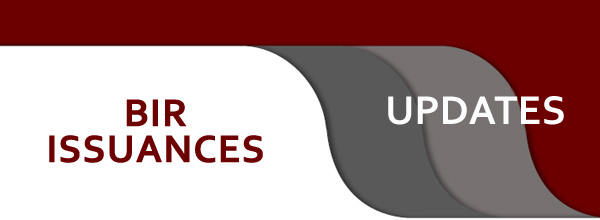
RMO No. 48-2024. November 15, 2024 –
This order implements the new DX Roadmap for CY 2025-2028, ordering that programs and activities to be undertaken must be aligned with the new roadmap.
The first pillar involves strengthening the BIR by providing employees with necessary training and restructuring.
The second pillar modernizes the digital backbone of the BIR by upgrading infrastructure to make things easier for taxpayers and to facilitate data-driven decision making.
The third pillar establishes a strong data governance and management framework to uphold data integrity, security, and usability.
The fourth pillar elevates taxpayer services by enhancing existing eServices and launching a one-stop Integrated Taxpayer Portal. (RMO No. 48-2024)RMO No. 047-2024. November 12, 2024 -
This order prescribes the use of revised BIR Form No. 1770 as a monitoring tool to more effectively profile taxpayers.
This order prescribes the use of revised BIR Form No. 1770 as a monitoring tool to more effectively profile taxpayers.
To accomplish this, the Data Warehousing and Systems Operations Division (DWSOD) shall generate the number of returns filed every 15th day of the month, and transmit the generated report via email to the Research and Statistics Division.
The data gathered in the reports will be consolidated using the prescribed revised BIR Form No. 1770 every 20th day of the following month. (RMO No. 27-2024)
RMC No. 123-2024. November 15, 2024 -
The 3-year validity period of the Certificate of Tax Exemption shall not apply to non-stock and non-profit educational institutions, Homeowners’ Associations, Non-stock savings and loan associations, and Employees’ retirement benefit plans.
The 3-year validity period of the Certificate of Tax Exemption shall not apply to the following:
- Non-stock and non-profit educational institutions;
- Homeowners’ associations;
- Non-stock savings and loan associations; and
- Employees’ retirement benefit plans.
Thus, the CTEs of the above shall remain valid unless recalled or revoked by the BIR.
RMC No. 124-2024, November 15, 2024 – This provides for the circularization of ERC Resolution No. 10, Series of 2023.
ERC Resolution No. 07, Series of 2011, dated 07 March 2011, otherwise known as A Resolution Allowing the Distribution Utilities to Include in their Monthly Transmission Cost the National Grid Corporation of the Philippines’ National Franchise Tax Billing provides for the inclusion of the 3% national franchise tax billed by NGCP as part of the DU’s total monthly transmission cost in the Transmission Rate Adjustment Mechanism (TRAM) formula. However, the Supreme Court in the cases of Republic v. Manila Electric Company (MERALCO)[2] and Maynilad Water Services, Inc. v. National Water and Resources Board, et.al.,[3] disallowed public utilities from passing on certain taxes as operating expenses to the consuming public.
As such, the ERC suspended the implementation of Resolution No. 7, Series of 2011, and the passing-on of the 3% national franchise of NGCP to its customers to be consistent with established jurisprudence and to the best interest of the public.
[2] G.R. No. 141314, November 15, 2002.
[3] G.R. Nos. 181764, 187380, 207444, 208207, 210147, 213227, 219362, and 239938, December 7, 2021.
RMC No. 125-2024, November 15, 2024 – This provides for the amendment of certain provisions of RMC No. 095-2017.
RMC No. 125-2024 is issued to provide clarification and guidance on the amendment of certain provisions of RMC No. 95-2017.
RMC No. 95-2017 provides for the guidelines on the proper tax treatment of the Government Securities Repurchase Program (GS Repo Program) governed by the Global Master Repurchase Agreement.
|
Amendment |
|
|
Section 2 |
The GS Repo Program will provide for the creation of an Interdealer Government Bond Repo Market with counterparties to include:
|
| Section 3 | Covered Entities intending to participate in the GS Repo Program shall be bound by the applicable SEC, BSP, and Insurance Commission regulations. |
| Section 4 |
Prior to entering into any Repo transaction, the participating Covered Entities shall be required by the BTr to comply with the following registration requirements: a. xxx b. Formally transmit to the concerned BIR Revenue District Office or the Large Taxpayer District Office, as the case may be, copies of the duly signed GMRAs and respective undertaking from the Covered Entities, which were previously stamped as received by the SSRD of the BTr. |
| Section 5 |
Within thirty (30) days after the close of the taxable year, the participating Covered Entities shall file with the concerned Revenue District Office or the Large Taxpayers Service (LTS) of the BIR through the Regular Large Taxpayers Audit Division 2 (RLTAD 2), for large taxpayers, an annual report - in soft copy - using the format provided in Annex "A", summarizing all Repo transactions for the taxable period, including subsequent sale, if any, of Repo Securities within the Repo Period. |
RMC No. 127-2024, November 18, 2024 – This provides for the waiver/removal of the certification fee.
Persons with low or no income seeking scholarships and job/livelihood programs can apply for a Certificate of Exemption. The application requires:
- A Certification of Low Income/No Income signed by the Barangay Chairman, a notarized affidavit, and a Special Power of Attorney if applying through a representative.
- Payment of a Php 100.00 certification fee and a Php 30.00 documentary stamp tax.
This Circular waives the Php 100.00 certification fee to provide financial assistance to these applicants, facilitating their access to career opportunities.
However, the PHP 30.00 documentary stamp tax remains unchanged, as it is mandated by the Tax Code.

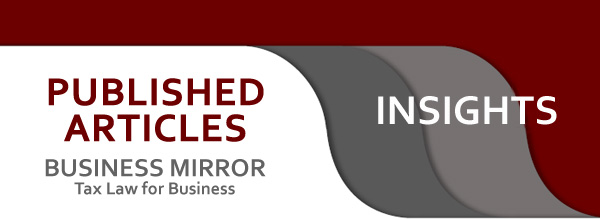
Reformed Tax Incentives under CREATE MORE
By Atty. Rodel C. Unciano
One significant amendment introduced by Republic Act No. 12066 or the Corporate Recovery and Tax Incentives for Enterprises to Maximize Opportunities for Reinvigorating the Economy (CREATE MORE) is the reformed bundle of tax incentives available to Registered Business Enterprises (RBE) duly registered with the Fiscal Incentives Review Board (FIRB) and other Investment Promotion Agencies (IPA).
Subject to certain conditions and period of availment, types of incentives that may be granted to registered projects or activities include 1) Income Tax Holiday (ITH), 2) Special Corporate Income Tax (SCIT) Rate, 3) Enhanced Deductions Regime (EDR), 4) Duty exemption on importation of capital equipment, raw materials, spare parts, or accessories, 5) Value Added Tax (VAT) exemption on importation and VAT zero-rating on local purchases, and 6) RBE local Tax.
ITH is an exemption from income tax on registered project or activity and is available for all both export and domestic market enterprises. The SCIT is a tax equivalent to five percent (5%) of gross income earned and is in lieu of all national and local taxes and local fees and charges. Only registered export enterprises may avail SCIT.
Under CREATE MORE, EDR has been made a separate tax regime where qualified enterprises shall be taxed at a rate equivalent to twenty percent (20%) of taxable income derived from registered projects or activities. This is in addition to the enhanced deductions enumerated under the law. Notably, CREATE MORE also increased from fifty percent (50%) to one hundred percent (100%) additional deduction on power expense incurred during the taxable year.
Registered export enterprises may opt one of the following: 1) ITH, which shall be followed by SCIT or EDR; or 2) SCIT, which shall be in lieu of all national and local taxes and local fees and charges and may be granted immediately at the start of commercial operations; or 3) EDR, which may be granted immediately at the start of commercial operations. Registered domestic market enterprises may opt for either 1) ITH, which shall be followed by EDR; or 2) EDR, which may be granted immediately at the start of commercial operations.
The RBE local tax may be imposed by the concerned local government unit through an ordinance issued by the concerned Sanggunian, at a rate of not more than two percent (2%) of an RBE's gross income during the ITH and EDR. This shall be in lieu of all local taxes and local fees and charges imposed by the local government unit. RBE local tax shall not be imposed on RBEs under SCIT.
Another significant amendment introduced by CREATE MORE is the different periods of availment of incentives for projects or activities approved by IPAs and FIRB. For export enterprises registered with IPAs, ITH shall be for a period of four (4) to seven (7) years, depending on location and industry priorities, followed by SCIT or EDR for ten (10) years, or SCIT or EDR for a maximum period of fourteen (14) to seventeen (17) years, depending on location and industry priorities.
For domestic market enterprises, ITH shall be for a period of four (4) to seven (7) years followed by EDR for ten (10) years, or EDR for a maximum period of fourteen (14) to seventeen (17) years, depending on location and industry priorities.
On the other hand, for export enterprises registered with the FIRB, the ITH incentive shall be for a period of four (4) to seven (7) years, depending on location and industry priorities, followed by SCIT or EDR for twenty (20) years, or SCIT or EDR for a maximum period of twenty-four (24) to twenty-seven (27) years, depending on location and industry priorities.
For domestic market enterprise, ITH incentive shall be for a period of four (4) to seven (7) years, followed by EDR for twenty (20) years, or EDR for a maximum period of twenty-four (24) to twenty-seven (27) years, depending on location and industry priorities.
As regards duty exemption, CREATE MORE modified the rules such that the exemption shall now apply to the importation of capital equipment, raw materials, spare parts, or accessories directly attributable to the registered project or activity of RBEs, including goods used for administrative purposes, unlike the old provision where the exemption applies only to those exclusively used in the registered project or activity.
For VAT, the exemption on importation and VAT zero-rating on local purchases shall only apply to goods and services directly attributable to the registered project or activity of a registered export enterprise, or a registered high-value domestic market enterprise, including expenses incidental thereto.
Subject to certain conditions, RBEs may continue to avail of the VAT zero-rating on local purchases and VAT exemption on importation, and duty exemption on importation for the entire registration period as an RBE, reckoned from the date of registration, if the RBEs continue to meet the terms and conditions of their registration.
True to its objective as encapsulated in its title, CREATE MORE is expected to maximize opportunities and reinvigorate the economy. Let’s support CREATE MORE for it to meet its objectives set to be achieved.
----------------------------------------------
For inquiries on the article, you may call or email
ATTY. RODEL C. UNCIANO
Partner
T: +63 2 8403 2001 loc. 380
This email address is being protected from spambots. You need JavaScript enabled to view it.


DISCLAIMER: The contents of this Insights are summaries of selected issuances from various government agencies, Court decisions and articles written by our experts. They are intended for guidance only and as such should not be regarded as a substitute for professional advice.
Copyright © 2025 by Du-Baladad and Associates (BDB Law). All rights reserved. No part of this issue covered by this copyright may be produced and/or used in any form or by any means – graphic, electronic and mechanical without the written permission of the publisher.

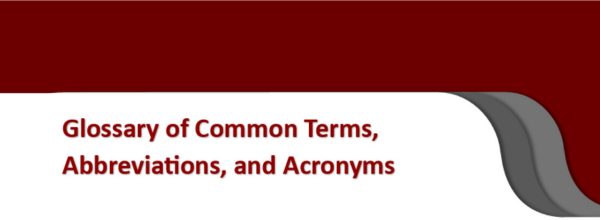
|
ABR |
- |
Annual Benefits Report |
|
ATIR |
- |
Annual Tax Incentives Report |
|
BIR |
- |
Bureau of Internal Revenue |
|
CIR |
- |
Commissioner of Internal Revenue |
|
CTA |
- |
Court of Tax Appeals |
|
EOPT |
- |
Ease of Paying Taxes |
|
IPAs |
- |
Investment Promotion Agencies |
|
IRR |
- |
Implementing Rules and Regulations |
|
FAN |
- |
Final Assessment Notice |
|
FNBS |
- |
Final Notice Before Seizure |
|
FLD |
- |
Formal Letter of Demand |
|
GS |
- |
Group Supervisor |
|
LOA |
- |
Letter of Authority |
|
NIC |
- |
Notice of Informal Conference |
|
ORUS |
- |
Online Registration and Update System |
|
PCL |
- |
Preliminary Collection Letter |
|
RA |
- |
Republic Act |
|
RBEs |
- |
Registered Business Enterprises |
|
RCC |
- |
Revised Corporation Code |
|
RMC |
- |
Revenue Memorandum Circular |
|
RMO |
- |
Revenue Memorandum Order |
|
RO |
- |
Revenue Officer |
|
RR |
- |
Revenue Regulations |
|
SEC |
- |
Securities and Exchange Commission |
|
SRC |
- |
Securities Regulation Code |
|
TCC |
- |
Tax Clearance Certificate |
|
VAT |
- |
Value Added Tax |




